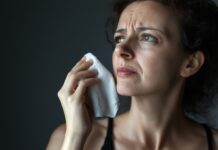Menopause marks the end of a woman’s menstrual cycles and is diagnosed after 12 consecutive months without a period. This natural biological process typically occurs between the ages of 45 and 55 and signifies the cessation of reproductive capabilities. Menopause is preceded by perimenopause, a transitional phase where the ovaries gradually produce less estrogen and progesterone, leading to irregular menstrual cycles and various symptoms. The biological process of menopause is the culmination of this transition, as the ovaries cease releasing eggs and hormone production declines significantly.
Age Range and Variability
The onset of menopause can vary widely among women. While the average age is 51, menopause can occur anytime from the 30s to the mid-50s or later. Factors such as genetics, smoking, and body weight can influence the timing. A woman often experiences menopause around the same age as her mother. It’s important to note that while menopause is a natural part of aging, it can also be induced by medical interventions.
Premature Menopause: Causes and Implications
Premature menopause, also known as primary ovarian insufficiency, occurs when a woman’s ovaries fail before the age of 40. Causes can include genetic factors, autoimmune diseases, smoking, or medical treatments such as chemotherapy. The implications of premature menopause are significant, as it can lead to earlier onset of menopause-related health risks and may impact psychological well-being due to the sudden change in fertility status.
Predictability and Influencing Factors
The predictability of menopause is challenging due to its individual variability. Factors that influence the onset and experience of menopause include lifestyle choices, such as smoking, which can accelerate the process, and ethnicity, which can affect the age of onset and symptom severity. Additionally, a woman’s health history and her mother’s menopausal age can offer some predictive insight.
Induced Menopause: Medical Interventions
Induced menopause can result from medical interventions such as a hysterectomy or oophorectomy, where the uterus and/or ovaries are surgically removed, or from treatments like chemotherapy and pelvic radiation. These interventions lead to an abrupt decline in hormone levels, often resulting in more severe menopausal symptoms compared to natural menopause. Women undergoing induced menopause may require specialized management to mitigate symptoms and address long-term health risks.
Understanding menopause is crucial for women approaching midlife, as it affects various aspects of health and quality of life. Recognizing the signs and preparing for the changes can help women navigate this transition more comfortably and with greater awareness of their health needs.
Symptoms and Health Changes During Menopause
Common Physical Symptoms
Menopause is characterized by a variety of physical symptoms that result from hormonal changes in a woman’s body. The most common physical symptoms include:
- Hot flashes: Sudden feelings of warmth, often accompanied by flushing and sweating.
- Night sweats: Hot flashes that occur at night, potentially disrupting sleep.
- Irregular periods: Changes in frequency, duration, and flow of menstrual periods.
- Vaginal dryness: Decreased moisture production leading to discomfort during intercourse.
- Urinary incontinence: Loss of bladder control, leading to leakage during activities or sudden urges to urinate.
- Weight gain: Changes in metabolism and body composition can lead to increased weight.
- Thinning hair and dry skin: Hormonal changes can affect skin and hair health.
Psychological and Emotional Impact
The transition into menopause can also have a significant psychological and emotional impact. Women may experience:
- Mood swings: Fluctuations in mood, including irritability and heightened emotions.
- Depression and anxiety: Feelings of sadness or worry that can be attributed to hormonal shifts and life changes.
- Cognitive changes: Difficulty concentrating and minor memory problems.
- Decreased libido: A reduction in sexual desire, which may be influenced by both physical discomfort and hormonal changes.
It is important to note that these symptoms can be managed with the help of healthcare providers, and treatments are available to alleviate discomfort.
Long-Term Health Risks
Menopause can increase the risk of certain long-term health conditions, including:
- Osteoporosis: A decrease in bone density, leading to an increased risk of fractures.
- Cardiovascular disease: Changes in heart and blood vessel health, potentially leading to heart disease.
- Urinary incontinence: Ongoing issues with bladder control.
These risks underscore the importance of maintaining a healthy lifestyle and engaging in regular health screenings post-menopause.
Variability of Symptom Experience
The experience of menopausal symptoms varies widely among women. Factors such as ethnicity, lifestyle, and overall health can influence the type and severity of symptoms. Some women may have a relatively smooth transition with minimal discomfort, while others may experience severe and disruptive symptoms. It is also possible for symptoms to change over time, with some diminishing and others emerging as a woman moves through perimenopause to postmenopause.
Understanding the variability of menopausal experiences is crucial for healthcare providers to offer personalized care and for women to feel validated in their individual journeys through this natural life stage.

From unhappy, dry, and sandpaper to silky, smooth and feeling good. That’s Cleo. Cleo is a 100% natural labial balm to moisture and soothe “your other lips”. Cleo is chemical-free, water-free, pH optimized and helps maintain and restore your delicate labial skin’s natural flora. Ideal for daily use or as needed. Get the most silky, lovable lips ever.
Menopause Management and Treatment Options
Hormonal and Non-Hormonal Interventions
Menopause management often begins with understanding the various treatment options available to alleviate symptoms. Hormonal interventions, such as estrogen therapy, are considered the most effective for hot flash relief and bone loss prevention. However, they are not suitable for everyone and come with potential risks, including cardiovascular issues and breast cancer. Vaginal estrogen and progestin are also used to address vaginal dryness and discomfort. Non-hormonal options include low-dose antidepressants like SSRIs, which can reduce hot flashes, and medications like gabapentin and clonidine for those who cannot use estrogen therapy. The recent introduction of Fezolinetant offers a hormone-free alternative for managing hot flashes.
Lifestyle Adjustments and Alternative Therapies
Lifestyle changes can significantly impact menopause symptoms. Simple measures such as dressing in layers, staying hydrated, and identifying triggers can help manage hot flashes. Vaginal lubricants and moisturizers can alleviate discomfort during intercourse, while regular sleep and relaxation techniques can improve mood and sleep quality. Alternative therapies like phytoestrogens, bioidentical hormones, and herbal supplements like black cohosh and red clover are used by some, but their effectiveness and safety are not always backed by scientific evidence. Mind and body practices, including yoga and acupuncture, may offer relief, though results vary.
Importance of Healthcare Provider Consultation
Consulting with a healthcare provider is crucial when considering menopause management options. They can help diagnose menopause through symptoms, medical history, and occasionally blood tests for FSH and estrogen levels. Providers can also guide the safe use of treatments, considering personal and family medical history, and help monitor the effectiveness and any potential side effects. Regular reviews of treatment plans are recommended to adjust to changing needs over time.
Navigating Health and Well-being Post-Menopause
Post-menopause, the focus shifts to maintaining health and preventing chronic conditions. Regular physical activity, a balanced diet, and not smoking are key lifestyle habits that support overall well-being. Medications to prevent or treat osteoporosis may be prescribed, along with vitamin D supplements to strengthen bones. It’s also important to continue monitoring for any new or persisting symptoms and to maintain regular healthcare appointments to address any emerging health concerns.
Fertility, Contraception, and Sexual Health
Fertility During Perimenopause
While fertility naturally declines with age, it is important to recognize that women are not fully protected from unplanned pregnancy until they have reached menopause, defined as 12 consecutive months without a menstrual period. Perimenopause, the transition phase leading up to menopause, can begin in a woman’s mid-30s or 40s, and during this time, menstrual cycles can become irregular, making it difficult to predict ovulation. Consequently, contraception should be used consistently until menopause is confirmed to prevent an unintended pregnancy.
Contraceptive Use and Recommendations
There are several contraceptive options available for perimenopausal women, each with its own set of benefits and considerations:
- Hormonal contraceptives (oral pills, patches, injections, vaginal rings) can regulate menstrual cycles, reduce bleeding, and provide relief from perimenopausal symptoms. However, they may mask the signs of menopause and are not recommended for women with certain health risks, such as a history of blood clots or estrogen-dependent cancers.
- Intrauterine devices (IUDs), both hormonal and non-hormonal, offer long-term protection against pregnancy and can be particularly effective during perimenopause.
- Barrier methods (condoms, diaphragms, spermicides) are non-hormonal and can be used as needed, but require disciplined use for effectiveness. Notably, condoms are the only contraceptive method that also provides protection against sexually transmitted infections (STIs).
- Sterilization offers a permanent solution for those certain they do not want future pregnancies.
It is recommended that women under 50 continue contraception for at least two years after their last period, and those over 50 for at least one year. Women considering hormone replacement therapy (HRT) should note that it is not a form of contraception.
Sexual Health and Risks Post-Menopause
Menopause can bring about significant changes in sexual health. A decrease in estrogen levels can lead to vaginal dryness, discomfort during intercourse, and changes in sexual desire. These physical changes, along with psychosexual and sociocultural factors, can affect a woman’s sexual experience and body image.
To manage these changes, women may consider:
- Menopausal hormone therapy (MHT) or testosterone therapy for those experiencing hypoactive sexual desire disorder (HSDD).
- Vaginal moisturizers and lubricants to alleviate dryness.
- Pelvic floor physiotherapy to address issues such as incontinence or prolapse.
Open communication with a partner, exploring new forms of intimacy, and seeking relationship counseling if needed can also support sexual well-being. It is crucial for women to consult with their healthcare provider regarding any concerns about sexual health or contraceptive needs during and after the transition into menopause.
Sociocultural and Psychological Perspectives on Menopause
Menopause in Different Cultures
The experience of menopause is not universal; it varies significantly across different cultures. In Western societies, menopause is often associated with a plethora of symptoms and is sometimes viewed negatively. However, in many non-Western cultures, menopause is seen as a time of liberation and increased social status, with fewer reported symptoms. This disparity suggests that cultural beliefs and lifestyle factors play a crucial role in shaping women’s experiences of menopause. For instance, the role of norepinephrine in hot flushes may be influenced by psychological factors such as stress and self-esteem, which are in turn affected by cultural norms and attitudes.
Impact on Personal and Professional Life
Menopause can have profound effects on a woman’s personal and professional life. Symptoms such as hot flashes, sleep disturbances, and cognitive complaints can impact work performance and social interactions. The transition may coincide with significant life events like children leaving home, known as the “empty nest syndrome,” or the redefinition of roles within the family and workplace. However, contemporary research has moved away from these outdated notions, focusing instead on the biopsychosocial model that emphasizes hormonal changes and their direct impact on mental health and quality of life.
Gender Norms and Family Dynamics
Gender norms and family dynamics also play a significant role during the menopause transition. In many cultures, a woman’s identity is closely tied to her fertility, and menopause can lead to a perceived loss of femininity or changes in status within the family. However, this transition can also bring about a reevaluation of personal goals and relationships, leading to a newfound sense of freedom and empowerment for some women. The psychological impact of menopause is complex, with factors such as self-esteem becoming more significant predictors of behaviors like intrasexual competition in the postmenopausal phase.
In conclusion, menopause is a multifaceted experience influenced by biological, psychological, and sociocultural factors. Understanding these perspectives is crucial for providing appropriate support and interventions to women navigating this transition. As global demographics shift towards an increasing population of postmenopausal women, it is imperative to address these issues within healthcare policies and to promote a more nuanced understanding of menopause across different cultures.
Do you know the three main ways that your body gets in touch with harmful chemicals with everyday products? Knowledge is Power!
The Ultimate Detox Guide will tell you how to lower your exposure to harmful chemicals!

Global Demographics and Public Health Implications
Growing Population of Postmenopausal Women
The demographic landscape is shifting significantly with the number of postmenopausal women on the rise. In 1990, there were approximately 467 million women aged 50 years or more, a figure that is projected to soar to 1.2 billion by 2030. This burgeoning demographic represents a substantial portion of the global population, with women living longer and healthier lives. As such, the implications for public health systems are profound, necessitating a reevaluation of health services to cater to the unique needs of this group.
Challenges in Awareness and Access to Services
Despite the growing number of postmenopausal women, awareness and access to menopause-related health services remain inadequate. Menopause is often shrouded in silence, not openly discussed within families or communities, and frequently overlooked in healthcare settings. Consequently, many women may be unaware that their symptoms are menopause-related or that effective treatments exist. The stigma and embarrassment associated with menopause can further inhibit women from seeking help. Additionally, healthcare providers may lack the necessary training to recognize and manage menopausal symptoms effectively, leaving a gap in care that needs to be addressed.
The Role of Health Policies and Government Support
Governmental health policies play a crucial role in shaping the availability and quality of menopause-related services. However, many governments have yet to prioritize menopause within their health agendas, particularly in regions where health funding is already stretched thin by other pressing concerns. The inclusion of menopause-related diagnosis, counseling, and treatment services in routine healthcare is essential for addressing this public health challenge. Support from government and health policies can ensure that women have access to the necessary care, thereby improving their quality of life and overall well-being during and after the menopausal transition.
Conclusion: The increasing population of postmenopausal women presents both challenges and opportunities for public health systems worldwide. Addressing the lack of awareness and access to services, alongside implementing supportive health policies, is imperative for the well-being of this significant and growing demographic. As women continue to live longer, healthier lives, it is essential that their postmenopausal years are met with the care and attention they deserve.
WHO’s Approach to Menopause and Future Directions
Raising Awareness and Advocacy
The World Health Organization (WHO) recognizes the importance of menopause as a significant phase in a woman’s life that impacts her health and well-being. To address the challenges and opportunities presented by menopause, WHO is actively working to raise awareness about its effects on both individual women and society at large. This includes highlighting the health and socioeconomic implications of menopause and advocating for better support systems. WHO’s advocacy efforts aim to ensure that menopause is understood not as an illness but as a natural life stage that may require medical attention and support.
Inclusion in Health Worker Training
WHO advocates for the inclusion of menopause-related education in the training curricula of health workers. By equipping healthcare providers with the knowledge to recognize perimenopausal and post-menopausal symptoms, WHO aims to improve the quality of care and support offered to women. This training is crucial for healthcare providers to offer informed counseling on treatment options and to promote healthy aging for women during and after the menopausal transition.
Life Course Approach to Health
Emphasizing a life course approach to health, WHO encourages the integration of menopause-related health support into broader healthcare services. This approach acknowledges that a woman’s health status during perimenopause is influenced by her health history and lifestyle choices. WHO’s life course approach aims to ensure that women have access to appropriate health information and services throughout their lives, including during the critical period of menopause.
Addressing the Needs of Transgender and Gender Diverse Individuals
WHO also recognizes the unique needs of transgender and gender diverse individuals who may experience menopause. The organization stresses the importance of inclusive healthcare that addresses the specific health concerns of these populations. WHO calls for healthcare providers to consider the diverse experiences of menopause and to refer individuals to specialist services when necessary, ensuring that all people receive the care and support they need during this life stage.
In conclusion, WHO’s approach to menopause is multifaceted, focusing on raising awareness, advocating for inclusive education for health workers, promoting a life course approach to health, and addressing the needs of all individuals experiencing menopause. By adopting these strategies, WHO aims to improve the health and quality of life for women and gender diverse individuals worldwide as they navigate the menopausal transition.




















